A Simple DIY Kalk Dripper
by Agu Luuk
Perhaps you've read in a book or magazine, or maybe read it somewhere online, that you need to "drip kalk" as your makeup water. Everyone makes it sound so easy that you really don't want to ask how to actually do it. You're wondering if it's expensive, is it difficult, and is it dangerous to your tank? The answers in order are: no, no, and no. When finished reading this web page, you'll be confidently dripping kalk like a pro.
You'll need a few tools: a drill, drill bits, scissors, and a hacksaw blade (optional).
You'll also need some supplies, so make your shopping list. The first stop in this shopping spree will be the grocery store, where you'll be buying your container, pickling lime, and measuring spoons. First, the container needs to be food grade, preferably made of plastic as glass gets to be too heavy, and secondly, it should have a screw-on plastic cap. Various sizes of bottled water or sports drink containers work well. Next, get some pickling lime, if they have any in stock. If they don't have any, that's not a problem; a suitable substitute can be found at our next stop. Finally, buy a set of plastic measuring spoons. Get the types that are long and thin, as they will have to fit in the mouth of the container.
The next stop is the local fish store. If pickling lime wasn't available at the grocery store, buy some kalkwasser powder here. You'll pay more, but what the heck, at least they have it in stock, and this project is generally so cheap that you can afford to splurge. Additionally, a length of rigid tubing will be needed; I use 3/16" thin wall tubing. You'll also need flexible tubing. However, before buying it, be sure it fits over the rigid tube easily but snugly. I've found most local fish stores stock flex tubing that is just a little bit too small and difficult to work with, so I stop by the local hardware store and get their flex tubing. The final item to pick up from the local fish store is a small package of plastic airline valves.
So now you have your supplies...
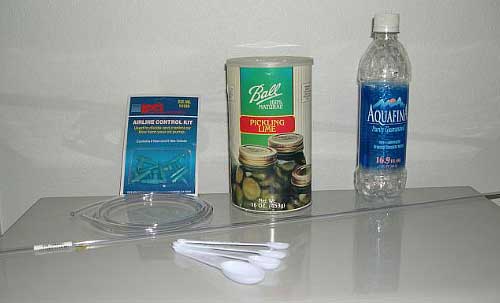 |
airline tubing, rigid airline tubing, and measuring spoons.
…and you're looking at this conglomeration of stuff and wondering what's next...
Grab the drill! The cap needs to have two holes drilled in it (see below). In my own case, I used a 7/32" drill bit. A bit of advice... before drilling the top, find a scrap piece of plastic and drill a test hole to confirm the flex tubing fits snugly. Once the correct bit size is determined, drill two holes in the cap, making sure they aren't too close to the edge, since the cap needs to be able to screw back onto the bottle.
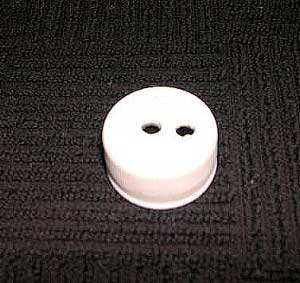 |
The manner in which to assemble the actual dripper depends on the container used and where it's located relative to the tank. For example, the length of the tubing is dependent upon how far the container will be located from the point you've chosen in the aquarium to dose the kalkwasser. In all cases, however, the down-tube inside the bottle should be about 3/4" above the bottom. There will be some residue that settles out and you don't want to add that to your system. I use rigid tubing on the outside because flex tends to be difficult to work with and I've been known to accidentally drip a whole container of kalk outside the tank when using only flex tubing.
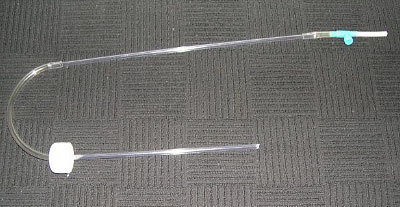 |
to the rigid tubing. A short length of flexible tubing connects the two
pieces of rigid tubing, and a small section of flex tubing is inserted
into the end where the valve is placed.
By now you're probably wondering about three things: 1) do you have to suck on the drip tube to start the siphon, 2) what does kalk taste like, and 3) what's with the second hole in the cap? Quick answers are: no, I've never tasted it, and it's the siphon starter. Cut another piece of flex tubing and insert it about 1/4" into the second hole. When blowing into the second tube it pressurizes the container and forces water into the siphon tube. This assumes, of course, that the airline valve is open. The DIY kalk dripper is now ready for use. Congratulations on a successful project!
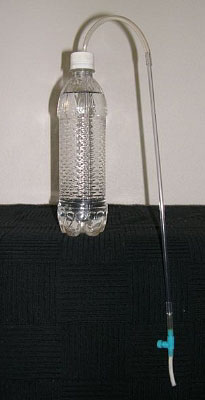 |
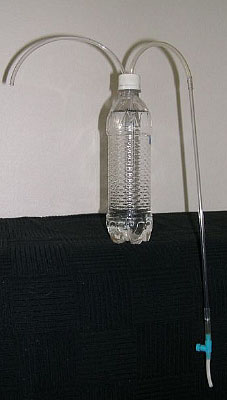 |
picture on the right.
Now that the kalk dripper is assembled, next comes the not-so-daunting task of using it.
It's important when planning, and prior to building, the kalk dripper, to find a location in the aquarium where it can drip into turbulent water. By placing the drip into turbulent water, better dispersion throughout the tank is achieved. Also make sure it's safely supported; a kalk container falling and spilling its entire contents can be a disastrous event! Plan the size of the container under the assumption that something will fail and the entire contents may possibly drain quickly into the tank. Some potential pitfalls could include such things as the airline valve falling off (unlikely), the container springing a leak (unlikely), or forgetting to turn down the drip rate after starting the siphon (likely). If the aquarium has a lot of evaporation, consider making two containers; one can be settling while the other is in operation and dripping kalk.
The general rule of thumb in mixing kalkwasser is one teaspoon of kalk powder per gallon of water. I am not qualified to get into the chemistry aspects, so don't ask me why. Fill the container about 1/3 with ro/di water and add the kalk. Swirl it around until it's in suspension, and add the rest of the water and cap the container. Be careful while doing this part, as kalk can be an irritant if it gets on your skin. I usually mix up the kalk in the evening and set the container in place without starting a drip. The next morning it takes just a few seconds to start the siphon and set the drip rate. The proper drip rate depends on your setup and the water volume of your system. For my small tanks, about one drip per second is slow enough to not cause sudden pH fluctuations and still get the kalk in the tank; obviously, larger tanks can handle faster additions of kalk.
There is some minor maintenance involved in dripping kalk. First, you'll discover a sludge accumulating in the bottom of the container; simply pour it out. Eventually, the airline valve will start to clog with calcium deposits. You'll realize this when the drip rate becomes hard to regulate or stops completely. Either dripping plain ro/di water through it every couple of weeks or removing the valve and soaking it in vinegar will easily solve this problem.
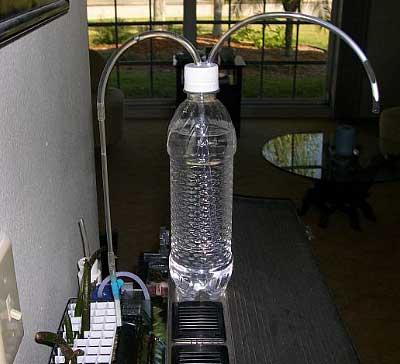 |
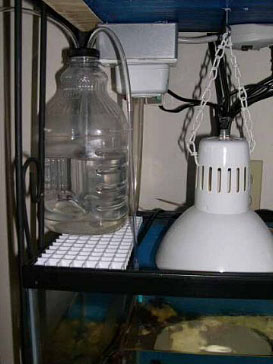 |
Credit goes to the owner of some long-forgotten website that had this kalk dripper posted. This is not an original design, and I don't know where it originally came from.